NUR241: Heart Failure Case Study - Nursing Interventions & Management
VerifiedAdded on 2023/04/19
|9
|2986
|436
Case Study
AI Summary
This case study assesses the care of a 70-year-old patient, Smith, experiencing an exacerbation of congestive heart failure, complicated by conditions like hypercholesterolemia, myocardial infarction, angina, hypertension, increased BMI, and type II diabetes. The study prioritizes addressing acute respiratory syndrome and the deteriorating state of congestive heart failure through interventions focused on restoring ineffective breathing patterns, clearing airway obstructions, and managing fatigue. Key nursing actions include respiratory rate monitoring, airway clearance techniques, and fatigue management strategies, all aimed at improving the patient's condition and preventing complications. The discharge plan emphasizes patient education on diet management, weight monitoring, and the importance of activity levels for cardiac rehabilitation to ensure continuity of care and reduce the risk of readmission. The role of the registered nurse is crucial in delivering targeted interventions and facilitating patient involvement in their care, promoting better health outcomes.

Nursing Case Study
University
Unit
Name
Tutor
University
Unit
Name
Tutor
Paraphrase This Document
Need a fresh take? Get an instant paraphrase of this document with our AI Paraphraser

2
Introduction
This case study assesses patient Smith aged 70 years old presenting exacerbation of
congestive heart failure. The patient indicative symptoms entail complains of chest pain,
weakness, SOB, fatigue, hacking cough illustrating bilateral coarse crackles. The patient has
a past illness of hypercholesterolemia, MI, angina, hypertension, increased BMI 34 and type
II diabetes. This essay offers key primary priorities of the patient presentation. Further key
nursing interventions which entail ineffective breathing restoration, ineffective airway
clearance and fatigue management for the patient and discharge plan for the patient are
presented. The role of nurses in delivering appropriate nursing intervention for the patient is
essential for the care process (Riley et al., 2016). As a form of care process continuity,
enhancing the ability of the patient through an appropriate discharge plan is key in ensuring
the prevention of patient readmission.
Primary Priorities
Nursing care priorities are essential for patient care management. Prioritizing patient
management seeks to envision the implication of the patient overall state and improve the
quality of care (Conway et al., 2017). The key health care nursing priority for the patient
entails care for the acute respiratory syndrome and deteriorating state of congestive heart
failure. Assessment using the ABCD framework for acute respiratory syndrome entails a
review of airway depicted by the hacking cough with signs of bibasal coarse crackles. The
occurrence of shortness of breath further the patient is depicting low oxygen saturation. The
breathing assessment of the patient depicts severe shortness of breath and unusual labored
breathing coupled up with tiredness. The blood circulation of the patient display anomalies as
observed using the ECF negative troponin index. The disability state of the patient reveals a
general weakness with immense fatigue. Patient exposure levels as indicated by the
temperature readings indicate hyperthermia, thus lowering of body temperature is beneficial
for the patient.
Congestive heart failure state of the patient reflects the lowered function of the respiratory
function. The airway assessment of the patient depicts shortness of breath characterized by
breath exertion (Benhase et al., 2018). The breathing status of the patent is lowered
characterized by the increased heart rate levels and elevated respiratory rates. The blood
circulation of the patient is lowered due to the occurrence of low heart rate and prehistory
Introduction
This case study assesses patient Smith aged 70 years old presenting exacerbation of
congestive heart failure. The patient indicative symptoms entail complains of chest pain,
weakness, SOB, fatigue, hacking cough illustrating bilateral coarse crackles. The patient has
a past illness of hypercholesterolemia, MI, angina, hypertension, increased BMI 34 and type
II diabetes. This essay offers key primary priorities of the patient presentation. Further key
nursing interventions which entail ineffective breathing restoration, ineffective airway
clearance and fatigue management for the patient and discharge plan for the patient are
presented. The role of nurses in delivering appropriate nursing intervention for the patient is
essential for the care process (Riley et al., 2016). As a form of care process continuity,
enhancing the ability of the patient through an appropriate discharge plan is key in ensuring
the prevention of patient readmission.
Primary Priorities
Nursing care priorities are essential for patient care management. Prioritizing patient
management seeks to envision the implication of the patient overall state and improve the
quality of care (Conway et al., 2017). The key health care nursing priority for the patient
entails care for the acute respiratory syndrome and deteriorating state of congestive heart
failure. Assessment using the ABCD framework for acute respiratory syndrome entails a
review of airway depicted by the hacking cough with signs of bibasal coarse crackles. The
occurrence of shortness of breath further the patient is depicting low oxygen saturation. The
breathing assessment of the patient depicts severe shortness of breath and unusual labored
breathing coupled up with tiredness. The blood circulation of the patient display anomalies as
observed using the ECF negative troponin index. The disability state of the patient reveals a
general weakness with immense fatigue. Patient exposure levels as indicated by the
temperature readings indicate hyperthermia, thus lowering of body temperature is beneficial
for the patient.
Congestive heart failure state of the patient reflects the lowered function of the respiratory
function. The airway assessment of the patient depicts shortness of breath characterized by
breath exertion (Benhase et al., 2018). The breathing status of the patent is lowered
characterized by the increased heart rate levels and elevated respiratory rates. The blood
circulation of the patient is lowered due to the occurrence of low heart rate and prehistory
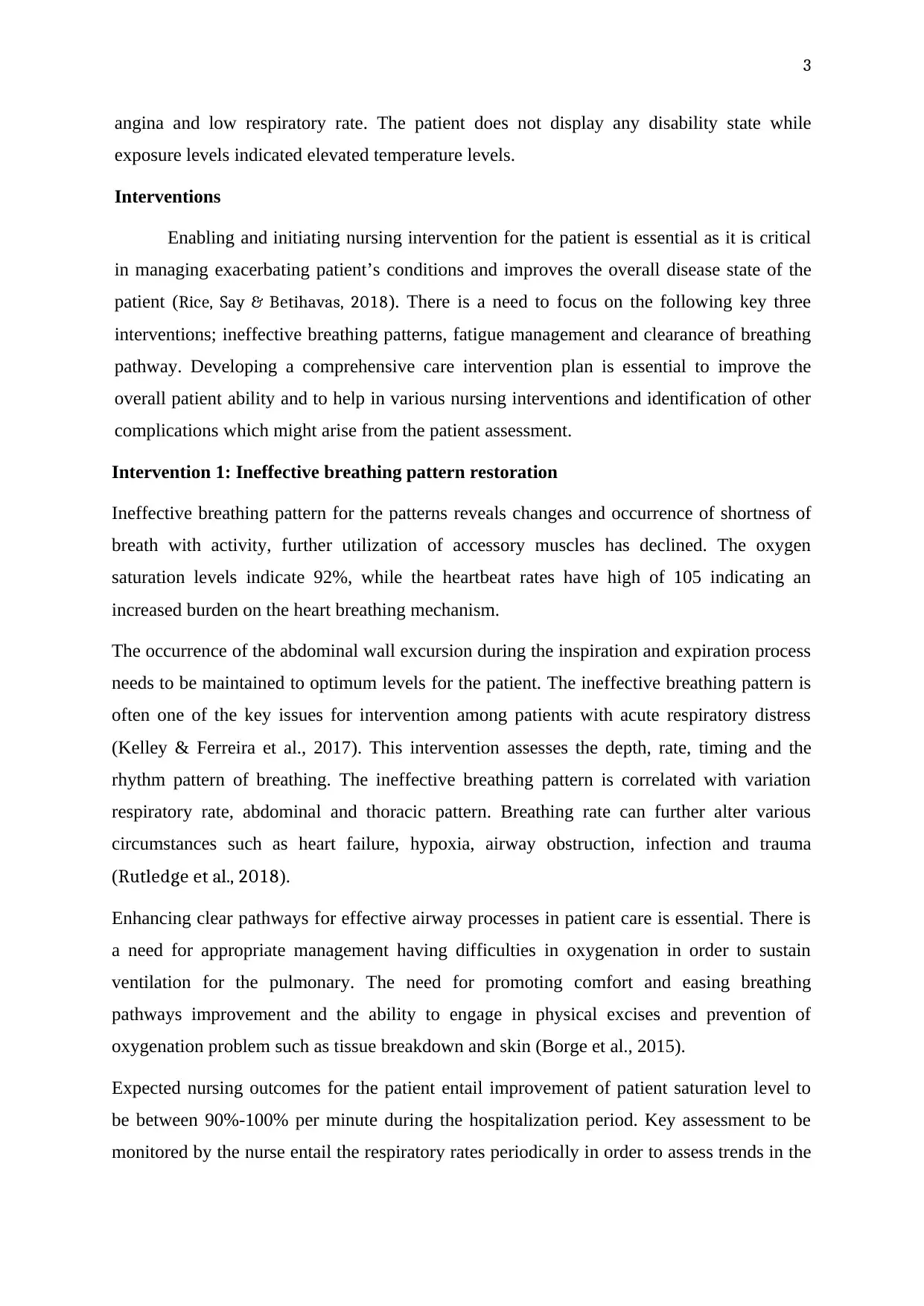
3
angina and low respiratory rate. The patient does not display any disability state while
exposure levels indicated elevated temperature levels.
Interventions
Enabling and initiating nursing intervention for the patient is essential as it is critical
in managing exacerbating patient’s conditions and improves the overall disease state of the
patient (Rice, Say & Betihavas, 2018). There is a need to focus on the following key three
interventions; ineffective breathing patterns, fatigue management and clearance of breathing
pathway. Developing a comprehensive care intervention plan is essential to improve the
overall patient ability and to help in various nursing interventions and identification of other
complications which might arise from the patient assessment.
Intervention 1: Ineffective breathing pattern restoration
Ineffective breathing pattern for the patterns reveals changes and occurrence of shortness of
breath with activity, further utilization of accessory muscles has declined. The oxygen
saturation levels indicate 92%, while the heartbeat rates have high of 105 indicating an
increased burden on the heart breathing mechanism.
The occurrence of the abdominal wall excursion during the inspiration and expiration process
needs to be maintained to optimum levels for the patient. The ineffective breathing pattern is
often one of the key issues for intervention among patients with acute respiratory distress
(Kelley & Ferreira et al., 2017). This intervention assesses the depth, rate, timing and the
rhythm pattern of breathing. The ineffective breathing pattern is correlated with variation
respiratory rate, abdominal and thoracic pattern. Breathing rate can further alter various
circumstances such as heart failure, hypoxia, airway obstruction, infection and trauma
(Rutledge et al., 2018).
Enhancing clear pathways for effective airway processes in patient care is essential. There is
a need for appropriate management having difficulties in oxygenation in order to sustain
ventilation for the pulmonary. The need for promoting comfort and easing breathing
pathways improvement and the ability to engage in physical excises and prevention of
oxygenation problem such as tissue breakdown and skin (Borge et al., 2015).
Expected nursing outcomes for the patient entail improvement of patient saturation level to
be between 90%-100% per minute during the hospitalization period. Key assessment to be
monitored by the nurse entail the respiratory rates periodically in order to assess trends in the
angina and low respiratory rate. The patient does not display any disability state while
exposure levels indicated elevated temperature levels.
Interventions
Enabling and initiating nursing intervention for the patient is essential as it is critical
in managing exacerbating patient’s conditions and improves the overall disease state of the
patient (Rice, Say & Betihavas, 2018). There is a need to focus on the following key three
interventions; ineffective breathing patterns, fatigue management and clearance of breathing
pathway. Developing a comprehensive care intervention plan is essential to improve the
overall patient ability and to help in various nursing interventions and identification of other
complications which might arise from the patient assessment.
Intervention 1: Ineffective breathing pattern restoration
Ineffective breathing pattern for the patterns reveals changes and occurrence of shortness of
breath with activity, further utilization of accessory muscles has declined. The oxygen
saturation levels indicate 92%, while the heartbeat rates have high of 105 indicating an
increased burden on the heart breathing mechanism.
The occurrence of the abdominal wall excursion during the inspiration and expiration process
needs to be maintained to optimum levels for the patient. The ineffective breathing pattern is
often one of the key issues for intervention among patients with acute respiratory distress
(Kelley & Ferreira et al., 2017). This intervention assesses the depth, rate, timing and the
rhythm pattern of breathing. The ineffective breathing pattern is correlated with variation
respiratory rate, abdominal and thoracic pattern. Breathing rate can further alter various
circumstances such as heart failure, hypoxia, airway obstruction, infection and trauma
(Rutledge et al., 2018).
Enhancing clear pathways for effective airway processes in patient care is essential. There is
a need for appropriate management having difficulties in oxygenation in order to sustain
ventilation for the pulmonary. The need for promoting comfort and easing breathing
pathways improvement and the ability to engage in physical excises and prevention of
oxygenation problem such as tissue breakdown and skin (Borge et al., 2015).
Expected nursing outcomes for the patient entail improvement of patient saturation level to
be between 90%-100% per minute during the hospitalization period. Key assessment to be
monitored by the nurse entail the respiratory rates periodically in order to assess trends in the
⊘ This is a preview!⊘
Do you want full access?
Subscribe today to unlock all pages.

Trusted by 1+ million students worldwide
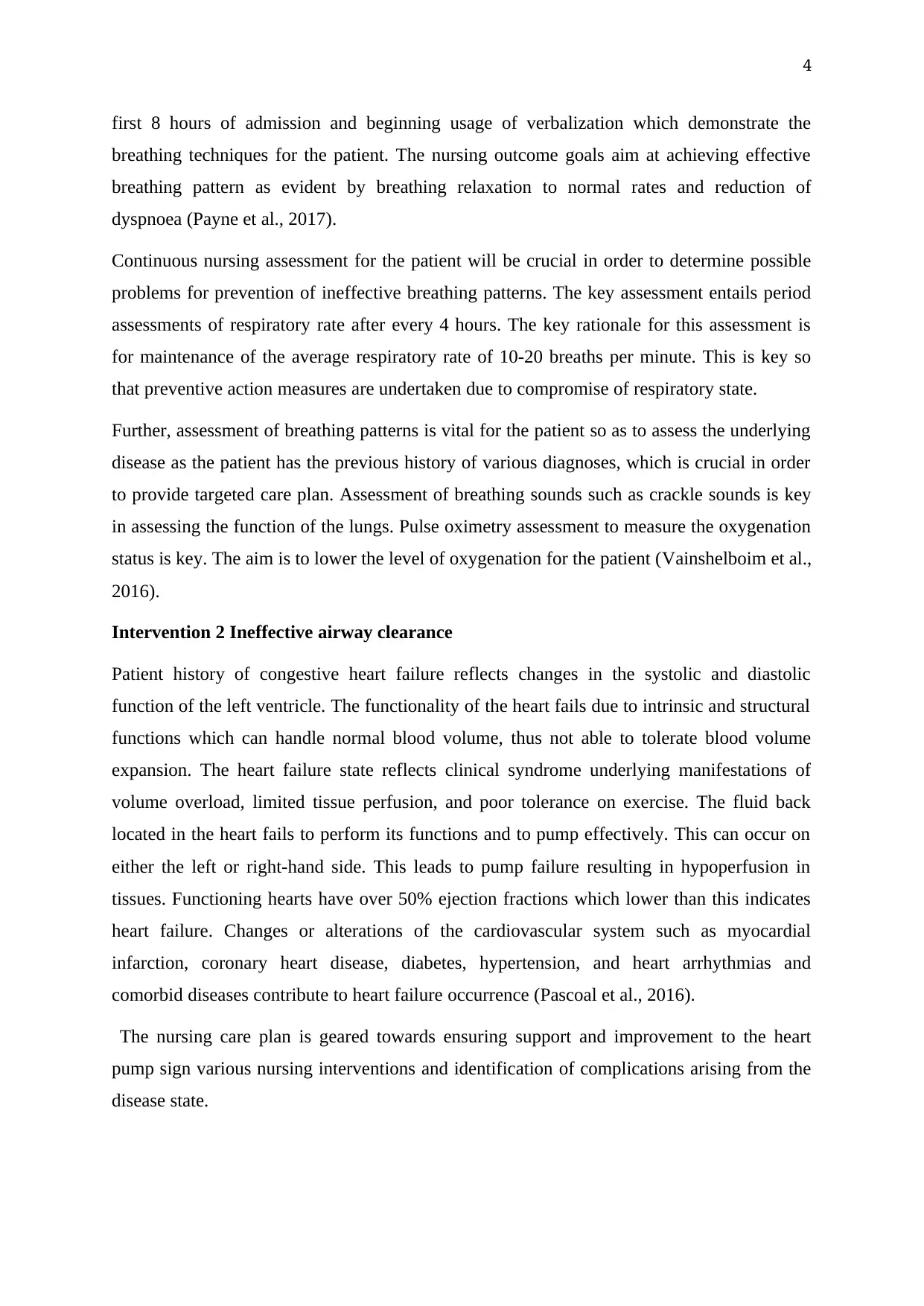
4
first 8 hours of admission and beginning usage of verbalization which demonstrate the
breathing techniques for the patient. The nursing outcome goals aim at achieving effective
breathing pattern as evident by breathing relaxation to normal rates and reduction of
dyspnoea (Payne et al., 2017).
Continuous nursing assessment for the patient will be crucial in order to determine possible
problems for prevention of ineffective breathing patterns. The key assessment entails period
assessments of respiratory rate after every 4 hours. The key rationale for this assessment is
for maintenance of the average respiratory rate of 10-20 breaths per minute. This is key so
that preventive action measures are undertaken due to compromise of respiratory state.
Further, assessment of breathing patterns is vital for the patient so as to assess the underlying
disease as the patient has the previous history of various diagnoses, which is crucial in order
to provide targeted care plan. Assessment of breathing sounds such as crackle sounds is key
in assessing the function of the lungs. Pulse oximetry assessment to measure the oxygenation
status is key. The aim is to lower the level of oxygenation for the patient (Vainshelboim et al.,
2016).
Intervention 2 Ineffective airway clearance
Patient history of congestive heart failure reflects changes in the systolic and diastolic
function of the left ventricle. The functionality of the heart fails due to intrinsic and structural
functions which can handle normal blood volume, thus not able to tolerate blood volume
expansion. The heart failure state reflects clinical syndrome underlying manifestations of
volume overload, limited tissue perfusion, and poor tolerance on exercise. The fluid back
located in the heart fails to perform its functions and to pump effectively. This can occur on
either the left or right-hand side. This leads to pump failure resulting in hypoperfusion in
tissues. Functioning hearts have over 50% ejection fractions which lower than this indicates
heart failure. Changes or alterations of the cardiovascular system such as myocardial
infarction, coronary heart disease, diabetes, hypertension, and heart arrhythmias and
comorbid diseases contribute to heart failure occurrence (Pascoal et al., 2016).
The nursing care plan is geared towards ensuring support and improvement to the heart
pump sign various nursing interventions and identification of complications arising from the
disease state.
first 8 hours of admission and beginning usage of verbalization which demonstrate the
breathing techniques for the patient. The nursing outcome goals aim at achieving effective
breathing pattern as evident by breathing relaxation to normal rates and reduction of
dyspnoea (Payne et al., 2017).
Continuous nursing assessment for the patient will be crucial in order to determine possible
problems for prevention of ineffective breathing patterns. The key assessment entails period
assessments of respiratory rate after every 4 hours. The key rationale for this assessment is
for maintenance of the average respiratory rate of 10-20 breaths per minute. This is key so
that preventive action measures are undertaken due to compromise of respiratory state.
Further, assessment of breathing patterns is vital for the patient so as to assess the underlying
disease as the patient has the previous history of various diagnoses, which is crucial in order
to provide targeted care plan. Assessment of breathing sounds such as crackle sounds is key
in assessing the function of the lungs. Pulse oximetry assessment to measure the oxygenation
status is key. The aim is to lower the level of oxygenation for the patient (Vainshelboim et al.,
2016).
Intervention 2 Ineffective airway clearance
Patient history of congestive heart failure reflects changes in the systolic and diastolic
function of the left ventricle. The functionality of the heart fails due to intrinsic and structural
functions which can handle normal blood volume, thus not able to tolerate blood volume
expansion. The heart failure state reflects clinical syndrome underlying manifestations of
volume overload, limited tissue perfusion, and poor tolerance on exercise. The fluid back
located in the heart fails to perform its functions and to pump effectively. This can occur on
either the left or right-hand side. This leads to pump failure resulting in hypoperfusion in
tissues. Functioning hearts have over 50% ejection fractions which lower than this indicates
heart failure. Changes or alterations of the cardiovascular system such as myocardial
infarction, coronary heart disease, diabetes, hypertension, and heart arrhythmias and
comorbid diseases contribute to heart failure occurrence (Pascoal et al., 2016).
The nursing care plan is geared towards ensuring support and improvement to the heart
pump sign various nursing interventions and identification of complications arising from the
disease state.
Paraphrase This Document
Need a fresh take? Get an instant paraphrase of this document with our AI Paraphraser

5
The exacerbating chest pain that is pleuritic in nature is indicative of a prior history of
myocardial infection for the patient. The feelings of chest pains are associated with anterior
infarction due to the left ventricular impairment developed from prior diagnosis.
Ineffective airway clearance emanates from the accumulation of secretions causing
obstructions in the respiratory tract thus hindering clean airway maintained. The mucosal
production at the lining of air passages forms on the walls. During inflammation, the
membranes are irritated and excess mucus is produced and retained in the tracheobronchial
tree. The inflammation leads to an increase in the level of secretion blocking the airways
making it difficult to maintain a clear pathway. In this case, it leads to an increase in the
respiratory rate tact as a compensatory mechanism of the body based on the obstructed
airways, thus depicting breathing difficulty as observed from the patient state (Beltrão et al.,
2015).
Enhancing airway clearance is desired to enhance the ability of the patient to establish and
have maintained airway patency. Key assessments relevant are the assessment of the
respiratory process and paroxysmal dyspnoea assessment. Ensuring accurate sitting position
for the patient through upright support in ¾ pillows is essential for acute shortness of breath.
Further administration of oxygen therapy can be administered as the airway is being cleared
to resume normal breathing patterns.
Intervention 3: Fatigue
Fatigue represents a state of overwhelming sustained exhaustion and reduced capacity for
physical and mental work activity. An occurrence of heart failure indicates the physiologic
state of the heart having the inability to pump blood to meet the metabolic demands of the
body due to inadequate cardiac output restoration. This can leads to a hypoxic state with a
lowered rate of metabolic waste removal which cases the patent to tire easily (Lainsamputty
& Chen, 2018).
The patient manifestation depicts general weakness and limited motion of activities. The
desired outcome care entails improving the sense of energy on the patient. Various activities
are initiated at this stage. The medication regime of the patient is reviewed with key rational
aimed to assessng how certain medications cause fatigue and exacerbation. Assessment of
vital signs entails an evaluation of the fluid status of the patient in response to
cardiopulmonary response. The patient further is inquired on the rate of fatigue so as to aid in
determining the degree of fatigability aiding care process plan care (Ranitya, 2015).
The exacerbating chest pain that is pleuritic in nature is indicative of a prior history of
myocardial infection for the patient. The feelings of chest pains are associated with anterior
infarction due to the left ventricular impairment developed from prior diagnosis.
Ineffective airway clearance emanates from the accumulation of secretions causing
obstructions in the respiratory tract thus hindering clean airway maintained. The mucosal
production at the lining of air passages forms on the walls. During inflammation, the
membranes are irritated and excess mucus is produced and retained in the tracheobronchial
tree. The inflammation leads to an increase in the level of secretion blocking the airways
making it difficult to maintain a clear pathway. In this case, it leads to an increase in the
respiratory rate tact as a compensatory mechanism of the body based on the obstructed
airways, thus depicting breathing difficulty as observed from the patient state (Beltrão et al.,
2015).
Enhancing airway clearance is desired to enhance the ability of the patient to establish and
have maintained airway patency. Key assessments relevant are the assessment of the
respiratory process and paroxysmal dyspnoea assessment. Ensuring accurate sitting position
for the patient through upright support in ¾ pillows is essential for acute shortness of breath.
Further administration of oxygen therapy can be administered as the airway is being cleared
to resume normal breathing patterns.
Intervention 3: Fatigue
Fatigue represents a state of overwhelming sustained exhaustion and reduced capacity for
physical and mental work activity. An occurrence of heart failure indicates the physiologic
state of the heart having the inability to pump blood to meet the metabolic demands of the
body due to inadequate cardiac output restoration. This can leads to a hypoxic state with a
lowered rate of metabolic waste removal which cases the patent to tire easily (Lainsamputty
& Chen, 2018).
The patient manifestation depicts general weakness and limited motion of activities. The
desired outcome care entails improving the sense of energy on the patient. Various activities
are initiated at this stage. The medication regime of the patient is reviewed with key rational
aimed to assessng how certain medications cause fatigue and exacerbation. Assessment of
vital signs entails an evaluation of the fluid status of the patient in response to
cardiopulmonary response. The patient further is inquired on the rate of fatigue so as to aid in
determining the degree of fatigability aiding care process plan care (Ranitya, 2015).
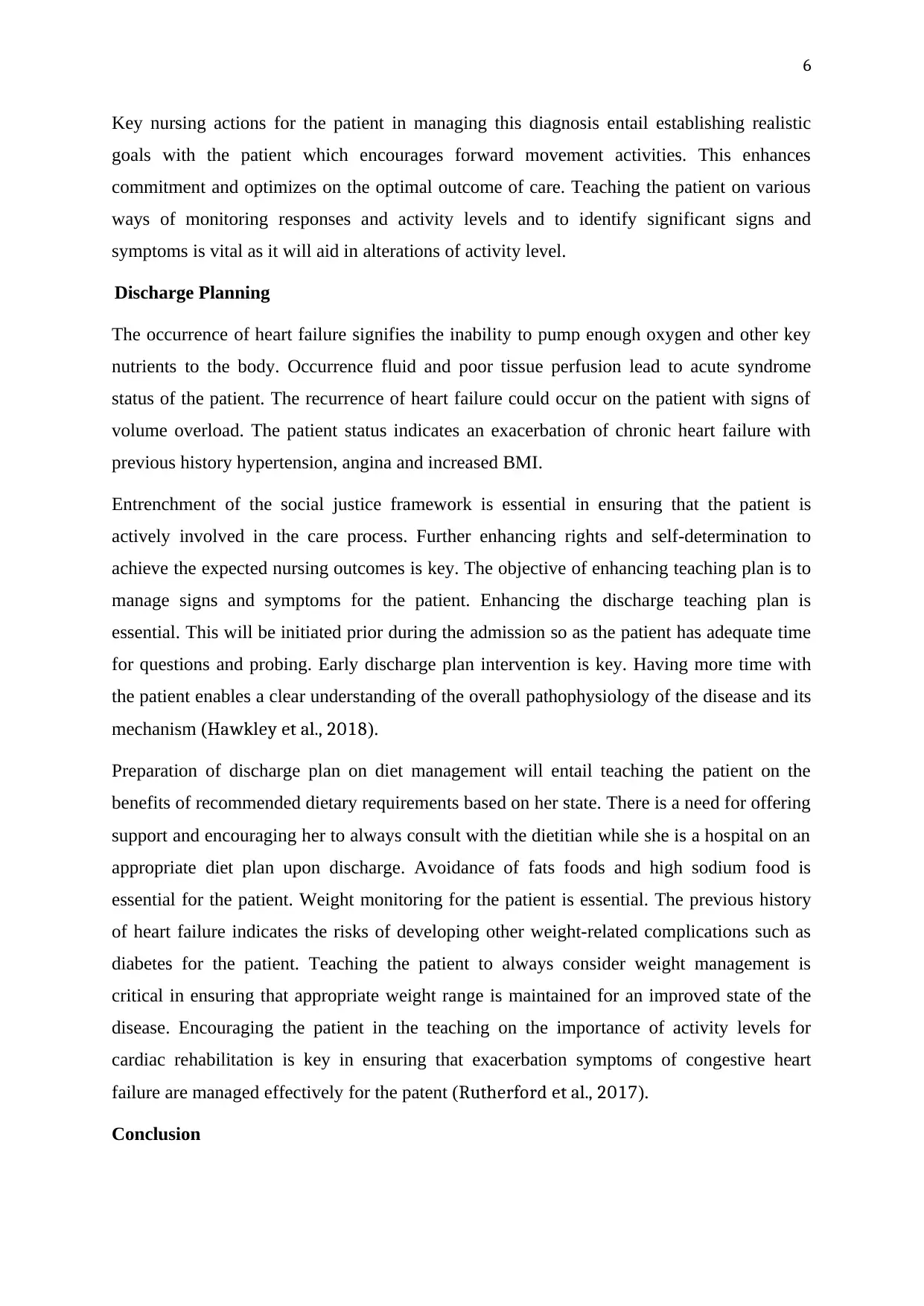
6
Key nursing actions for the patient in managing this diagnosis entail establishing realistic
goals with the patient which encourages forward movement activities. This enhances
commitment and optimizes on the optimal outcome of care. Teaching the patient on various
ways of monitoring responses and activity levels and to identify significant signs and
symptoms is vital as it will aid in alterations of activity level.
Discharge Planning
The occurrence of heart failure signifies the inability to pump enough oxygen and other key
nutrients to the body. Occurrence fluid and poor tissue perfusion lead to acute syndrome
status of the patient. The recurrence of heart failure could occur on the patient with signs of
volume overload. The patient status indicates an exacerbation of chronic heart failure with
previous history hypertension, angina and increased BMI.
Entrenchment of the social justice framework is essential in ensuring that the patient is
actively involved in the care process. Further enhancing rights and self-determination to
achieve the expected nursing outcomes is key. The objective of enhancing teaching plan is to
manage signs and symptoms for the patient. Enhancing the discharge teaching plan is
essential. This will be initiated prior during the admission so as the patient has adequate time
for questions and probing. Early discharge plan intervention is key. Having more time with
the patient enables a clear understanding of the overall pathophysiology of the disease and its
mechanism (Hawkley et al., 2018).
Preparation of discharge plan on diet management will entail teaching the patient on the
benefits of recommended dietary requirements based on her state. There is a need for offering
support and encouraging her to always consult with the dietitian while she is a hospital on an
appropriate diet plan upon discharge. Avoidance of fats foods and high sodium food is
essential for the patient. Weight monitoring for the patient is essential. The previous history
of heart failure indicates the risks of developing other weight-related complications such as
diabetes for the patient. Teaching the patient to always consider weight management is
critical in ensuring that appropriate weight range is maintained for an improved state of the
disease. Encouraging the patient in the teaching on the importance of activity levels for
cardiac rehabilitation is key in ensuring that exacerbation symptoms of congestive heart
failure are managed effectively for the patent (Rutherford et al., 2017).
Conclusion
Key nursing actions for the patient in managing this diagnosis entail establishing realistic
goals with the patient which encourages forward movement activities. This enhances
commitment and optimizes on the optimal outcome of care. Teaching the patient on various
ways of monitoring responses and activity levels and to identify significant signs and
symptoms is vital as it will aid in alterations of activity level.
Discharge Planning
The occurrence of heart failure signifies the inability to pump enough oxygen and other key
nutrients to the body. Occurrence fluid and poor tissue perfusion lead to acute syndrome
status of the patient. The recurrence of heart failure could occur on the patient with signs of
volume overload. The patient status indicates an exacerbation of chronic heart failure with
previous history hypertension, angina and increased BMI.
Entrenchment of the social justice framework is essential in ensuring that the patient is
actively involved in the care process. Further enhancing rights and self-determination to
achieve the expected nursing outcomes is key. The objective of enhancing teaching plan is to
manage signs and symptoms for the patient. Enhancing the discharge teaching plan is
essential. This will be initiated prior during the admission so as the patient has adequate time
for questions and probing. Early discharge plan intervention is key. Having more time with
the patient enables a clear understanding of the overall pathophysiology of the disease and its
mechanism (Hawkley et al., 2018).
Preparation of discharge plan on diet management will entail teaching the patient on the
benefits of recommended dietary requirements based on her state. There is a need for offering
support and encouraging her to always consult with the dietitian while she is a hospital on an
appropriate diet plan upon discharge. Avoidance of fats foods and high sodium food is
essential for the patient. Weight monitoring for the patient is essential. The previous history
of heart failure indicates the risks of developing other weight-related complications such as
diabetes for the patient. Teaching the patient to always consider weight management is
critical in ensuring that appropriate weight range is maintained for an improved state of the
disease. Encouraging the patient in the teaching on the importance of activity levels for
cardiac rehabilitation is key in ensuring that exacerbation symptoms of congestive heart
failure are managed effectively for the patent (Rutherford et al., 2017).
Conclusion
⊘ This is a preview!⊘
Do you want full access?
Subscribe today to unlock all pages.

Trusted by 1+ million students worldwide
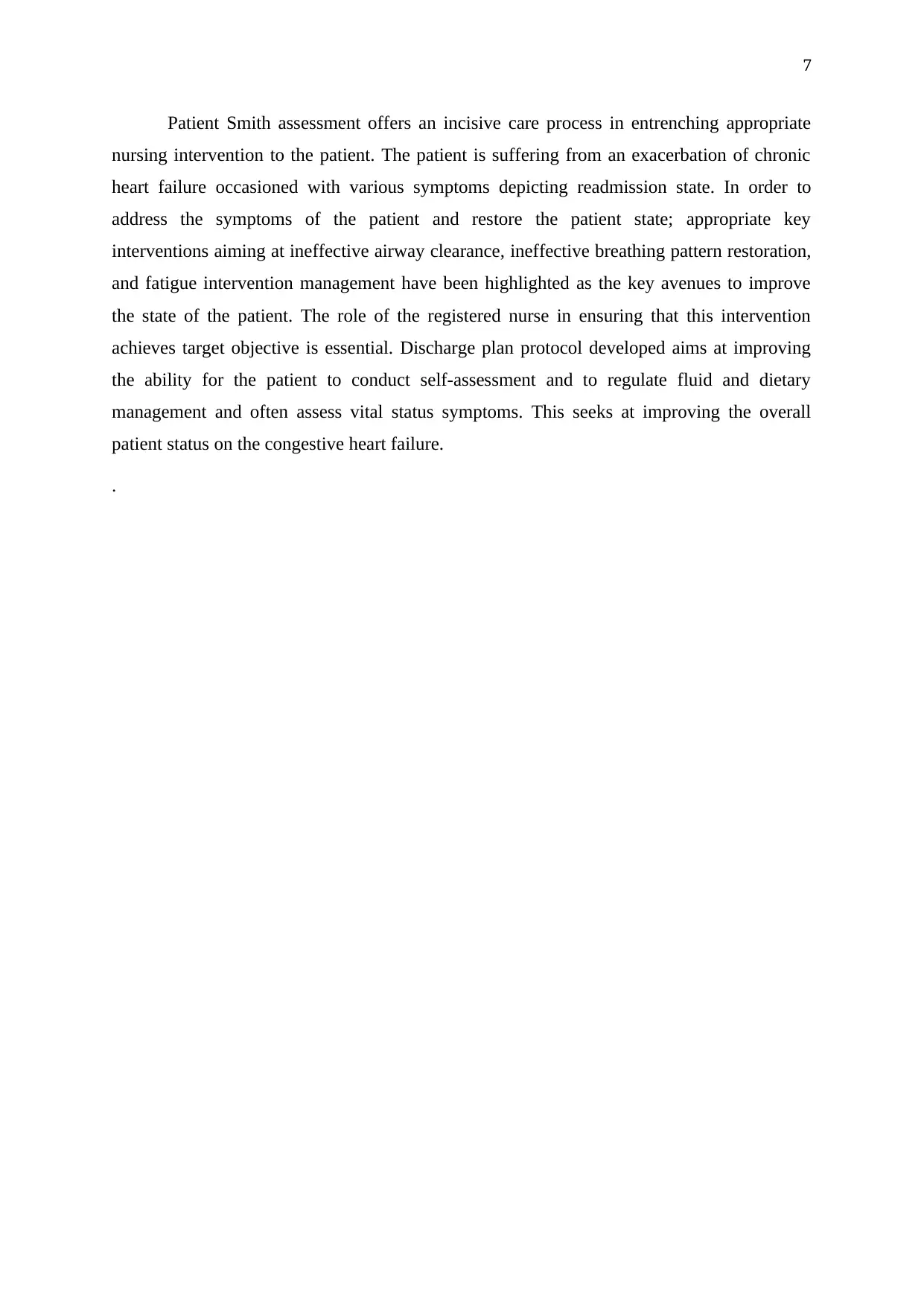
7
Patient Smith assessment offers an incisive care process in entrenching appropriate
nursing intervention to the patient. The patient is suffering from an exacerbation of chronic
heart failure occasioned with various symptoms depicting readmission state. In order to
address the symptoms of the patient and restore the patient state; appropriate key
interventions aiming at ineffective airway clearance, ineffective breathing pattern restoration,
and fatigue intervention management have been highlighted as the key avenues to improve
the state of the patient. The role of the registered nurse in ensuring that this intervention
achieves target objective is essential. Discharge plan protocol developed aims at improving
the ability for the patient to conduct self-assessment and to regulate fluid and dietary
management and often assess vital status symptoms. This seeks at improving the overall
patient status on the congestive heart failure.
.
Patient Smith assessment offers an incisive care process in entrenching appropriate
nursing intervention to the patient. The patient is suffering from an exacerbation of chronic
heart failure occasioned with various symptoms depicting readmission state. In order to
address the symptoms of the patient and restore the patient state; appropriate key
interventions aiming at ineffective airway clearance, ineffective breathing pattern restoration,
and fatigue intervention management have been highlighted as the key avenues to improve
the state of the patient. The role of the registered nurse in ensuring that this intervention
achieves target objective is essential. Discharge plan protocol developed aims at improving
the ability for the patient to conduct self-assessment and to regulate fluid and dietary
management and often assess vital status symptoms. This seeks at improving the overall
patient status on the congestive heart failure.
.
Paraphrase This Document
Need a fresh take? Get an instant paraphrase of this document with our AI Paraphraser
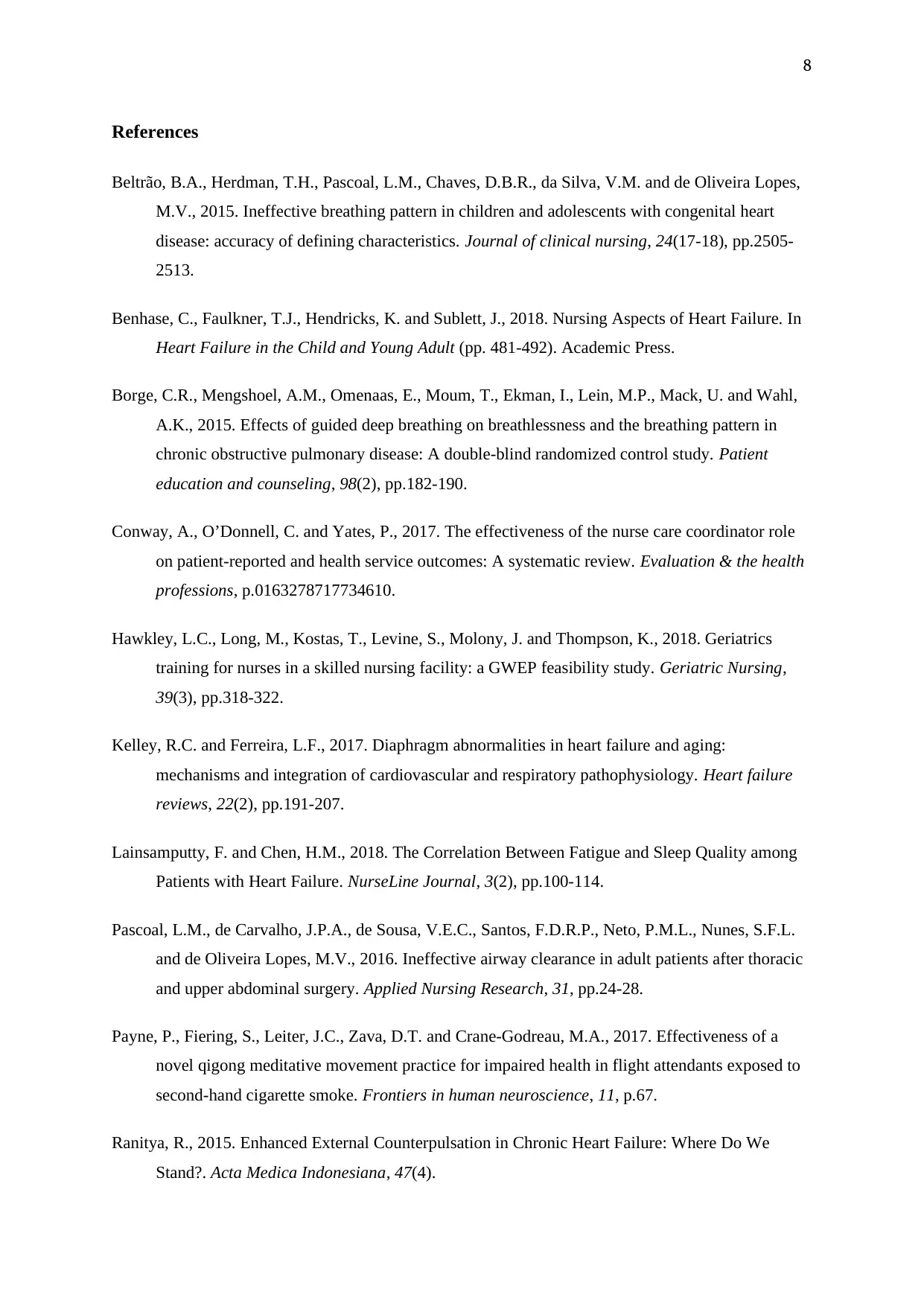
8
References
Beltrão, B.A., Herdman, T.H., Pascoal, L.M., Chaves, D.B.R., da Silva, V.M. and de Oliveira Lopes,
M.V., 2015. Ineffective breathing pattern in children and adolescents with congenital heart
disease: accuracy of defining characteristics. Journal of clinical nursing, 24(17-18), pp.2505-
2513.
Benhase, C., Faulkner, T.J., Hendricks, K. and Sublett, J., 2018. Nursing Aspects of Heart Failure. In
Heart Failure in the Child and Young Adult (pp. 481-492). Academic Press.
Borge, C.R., Mengshoel, A.M., Omenaas, E., Moum, T., Ekman, I., Lein, M.P., Mack, U. and Wahl,
A.K., 2015. Effects of guided deep breathing on breathlessness and the breathing pattern in
chronic obstructive pulmonary disease: A double-blind randomized control study. Patient
education and counseling, 98(2), pp.182-190.
Conway, A., O’Donnell, C. and Yates, P., 2017. The effectiveness of the nurse care coordinator role
on patient-reported and health service outcomes: A systematic review. Evaluation & the health
professions, p.0163278717734610.
Hawkley, L.C., Long, M., Kostas, T., Levine, S., Molony, J. and Thompson, K., 2018. Geriatrics
training for nurses in a skilled nursing facility: a GWEP feasibility study. Geriatric Nursing,
39(3), pp.318-322.
Kelley, R.C. and Ferreira, L.F., 2017. Diaphragm abnormalities in heart failure and aging:
mechanisms and integration of cardiovascular and respiratory pathophysiology. Heart failure
reviews, 22(2), pp.191-207.
Lainsamputty, F. and Chen, H.M., 2018. The Correlation Between Fatigue and Sleep Quality among
Patients with Heart Failure. NurseLine Journal, 3(2), pp.100-114.
Pascoal, L.M., de Carvalho, J.P.A., de Sousa, V.E.C., Santos, F.D.R.P., Neto, P.M.L., Nunes, S.F.L.
and de Oliveira Lopes, M.V., 2016. Ineffective airway clearance in adult patients after thoracic
and upper abdominal surgery. Applied Nursing Research, 31, pp.24-28.
Payne, P., Fiering, S., Leiter, J.C., Zava, D.T. and Crane-Godreau, M.A., 2017. Effectiveness of a
novel qigong meditative movement practice for impaired health in flight attendants exposed to
second-hand cigarette smoke. Frontiers in human neuroscience, 11, p.67.
Ranitya, R., 2015. Enhanced External Counterpulsation in Chronic Heart Failure: Where Do We
Stand?. Acta Medica Indonesiana, 47(4).
References
Beltrão, B.A., Herdman, T.H., Pascoal, L.M., Chaves, D.B.R., da Silva, V.M. and de Oliveira Lopes,
M.V., 2015. Ineffective breathing pattern in children and adolescents with congenital heart
disease: accuracy of defining characteristics. Journal of clinical nursing, 24(17-18), pp.2505-
2513.
Benhase, C., Faulkner, T.J., Hendricks, K. and Sublett, J., 2018. Nursing Aspects of Heart Failure. In
Heart Failure in the Child and Young Adult (pp. 481-492). Academic Press.
Borge, C.R., Mengshoel, A.M., Omenaas, E., Moum, T., Ekman, I., Lein, M.P., Mack, U. and Wahl,
A.K., 2015. Effects of guided deep breathing on breathlessness and the breathing pattern in
chronic obstructive pulmonary disease: A double-blind randomized control study. Patient
education and counseling, 98(2), pp.182-190.
Conway, A., O’Donnell, C. and Yates, P., 2017. The effectiveness of the nurse care coordinator role
on patient-reported and health service outcomes: A systematic review. Evaluation & the health
professions, p.0163278717734610.
Hawkley, L.C., Long, M., Kostas, T., Levine, S., Molony, J. and Thompson, K., 2018. Geriatrics
training for nurses in a skilled nursing facility: a GWEP feasibility study. Geriatric Nursing,
39(3), pp.318-322.
Kelley, R.C. and Ferreira, L.F., 2017. Diaphragm abnormalities in heart failure and aging:
mechanisms and integration of cardiovascular and respiratory pathophysiology. Heart failure
reviews, 22(2), pp.191-207.
Lainsamputty, F. and Chen, H.M., 2018. The Correlation Between Fatigue and Sleep Quality among
Patients with Heart Failure. NurseLine Journal, 3(2), pp.100-114.
Pascoal, L.M., de Carvalho, J.P.A., de Sousa, V.E.C., Santos, F.D.R.P., Neto, P.M.L., Nunes, S.F.L.
and de Oliveira Lopes, M.V., 2016. Ineffective airway clearance in adult patients after thoracic
and upper abdominal surgery. Applied Nursing Research, 31, pp.24-28.
Payne, P., Fiering, S., Leiter, J.C., Zava, D.T. and Crane-Godreau, M.A., 2017. Effectiveness of a
novel qigong meditative movement practice for impaired health in flight attendants exposed to
second-hand cigarette smoke. Frontiers in human neuroscience, 11, p.67.
Ranitya, R., 2015. Enhanced External Counterpulsation in Chronic Heart Failure: Where Do We
Stand?. Acta Medica Indonesiana, 47(4).

9
Rice, H., Say, R. and Betihavas, V., 2018. The effect of nurse-led education on hospitalisation,
readmission, quality of life and cost in adults with heart failure. A systematic review. Patient
education and counseling, 101(3), pp.363-374.
Riley, J.P., Astin, F., Crespo‐Leiro, M.G., Deaton, C.M., Kienhorst, J., Lambrinou, E., McDonagh,
T.A., Rushton, C.A., Stromberg, A., Filippatos, G. and Anker, S.D., 2016. Heart Failure
Association of the European Society of Cardiology heart failure nurse curriculum. European
journal of heart failure, 18(7), pp.736-743.
Rutherford, M. M. 2017. Enhanced RN role in behavioral health care: an untapped resource. Nursing
Economics, 35(2), pp. 88-95.
Rutledge, T., Atkinson, J.H., Holloway, R., Chircop-Rollick, T., D'Andrea, J., Garfin, S.R., Patel, S.,
Penzien, D.B., Wallace, M., Weickgenant, A.L. and Slater, M., 2018. Randomized Controlled
Trial of Nurse-Delivered Cognitive-Behavioral Therapy Versus Supportive Psychotherapy
Telehealth Interventions for Chronic Back Pain. The Journal of Pain, 19(9), pp.1033-1039.
Vainshelboim, B., Oliveira, J., Fox, B.D. and Kramer, M.R., 2016. The prognostic role of ventilatory
inefficiency and exercise capacity in idiopathic pulmonary fibrosis. Respiratory care, 61(8),
pp.1100-1109.
Rice, H., Say, R. and Betihavas, V., 2018. The effect of nurse-led education on hospitalisation,
readmission, quality of life and cost in adults with heart failure. A systematic review. Patient
education and counseling, 101(3), pp.363-374.
Riley, J.P., Astin, F., Crespo‐Leiro, M.G., Deaton, C.M., Kienhorst, J., Lambrinou, E., McDonagh,
T.A., Rushton, C.A., Stromberg, A., Filippatos, G. and Anker, S.D., 2016. Heart Failure
Association of the European Society of Cardiology heart failure nurse curriculum. European
journal of heart failure, 18(7), pp.736-743.
Rutherford, M. M. 2017. Enhanced RN role in behavioral health care: an untapped resource. Nursing
Economics, 35(2), pp. 88-95.
Rutledge, T., Atkinson, J.H., Holloway, R., Chircop-Rollick, T., D'Andrea, J., Garfin, S.R., Patel, S.,
Penzien, D.B., Wallace, M., Weickgenant, A.L. and Slater, M., 2018. Randomized Controlled
Trial of Nurse-Delivered Cognitive-Behavioral Therapy Versus Supportive Psychotherapy
Telehealth Interventions for Chronic Back Pain. The Journal of Pain, 19(9), pp.1033-1039.
Vainshelboim, B., Oliveira, J., Fox, B.D. and Kramer, M.R., 2016. The prognostic role of ventilatory
inefficiency and exercise capacity in idiopathic pulmonary fibrosis. Respiratory care, 61(8),
pp.1100-1109.
⊘ This is a preview!⊘
Do you want full access?
Subscribe today to unlock all pages.

Trusted by 1+ million students worldwide
1 out of 9
Related Documents
Your All-in-One AI-Powered Toolkit for Academic Success.
+13062052269
info@desklib.com
Available 24*7 on WhatsApp / Email
![[object Object]](/_next/static/media/star-bottom.7253800d.svg)
Unlock your academic potential
Copyright © 2020–2025 A2Z Services. All Rights Reserved. Developed and managed by ZUCOL.





